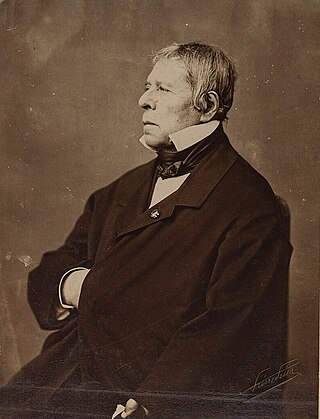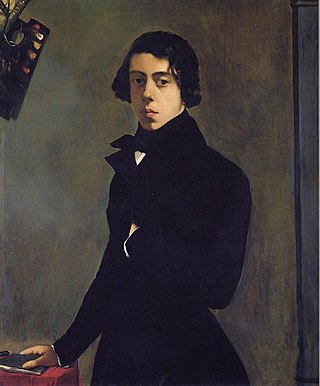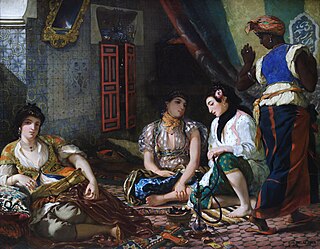
Jean-Auguste-Dominique Ingres was a French Neoclassical painter. Ingres was profoundly influenced by past artistic traditions and aspired to become the guardian of academic orthodoxy against the ascendant Romantic style. Although he considered himself a painter of history in the tradition of Nicolas Poussin and Jacques-Louis David, it is his portraits, both painted and drawn, that are recognized as his greatest legacy. His expressive distortions of form and space made him an important precursor of modern art, influencing Henri Matisse, Pablo Picasso, and other modernists.

Ferdinand Victor Eugène Delacroix was a French Romantic artist who was regarded as the leader of the French Romantic school.

The Palais Bourbon is the meeting place of the National Assembly, the lower legislative chamber of the French Parliament. It is in the 7th arrondissement of Paris, on the Rive Gauche of the Seine across from the Place de la Concorde.

Théodore Chassériau was a Dominican-born French Romantic painter noted for his portraits, historical and religious paintings, allegorical murals, and Orientalist images inspired by his travels to Algeria. Early in his career he painted in a Neoclassical style close to that of his teacher Jean-Auguste-Dominique Ingres, but in his later works he was strongly influenced by the Romantic style of Eugène Delacroix. He was a prolific draftsman, and made a suite of prints to illustrate Shakespeare's Othello. The portrait he painted at the age of 15 of Prosper Marilhat makes Chassériau the youngest painter exhibited at the Louvre museum.

Mathurin Régnier was a French satirist.

Women of Algiers in their Apartment is the title of two oil on canvas paintings by the French Romantic painter Eugène Delacroix.

Taking its name from medieval troubadours, the Troubadour Style is a rather derisive term, in English usually applied to French historical painting of the early 19th century with idealised depictions of the Middle Ages and the Renaissance. In French it also refers to the equivalent architectural styles. It can be seen as an aspect of Romanticism and a reaction against Neoclassicism, which was coming to an end at the end of the Consulate, and became particularly associated with Josephine Bonaparte and Caroline Ferdinande Louise, duchesse de Berry. In architecture the style was an exuberant French equivalent to the Gothic Revival of the Germanic and Anglophone countries. The style related to contemporary developments in French literature, and music, but the term is usually restricted to painting and architecture.

The Galerie des Batailles is a gallery occupying the first floor of the Aile du Midi of the Palace of Versailles, joining onto the grand and petit appartement de la reine. 120 m (390 ft) long and 13 m (43 ft) wide, it is an epigone of the Grande Galerie of the Louvre and was intended to glorify French military history from the Battle of Tolbiac to the Battle of Wagram.

Jean-Jacques Champin was a French painter, watercolorist and lithographer.

Louis Antoine Léon Riesener was a French Romantic painter.

Philippe-Auguste Jeanron was a French painter, curator and writer. Throughout his life he was a passionate republican. His genre pictures typically depicted common people. He opposed the July Monarchy. After the February Revolution of 1848 was made head of National Museums and Director of the Louvre, where he introduced important innovations in the preservation, classification and arrangement of the collections. Later he became director of the museum in Marseilles.

Adolphe Regnier was a French philologist.

Louis Michel Halbou (1730–1809) was a French draughtsman and engraver of the pre-Romantic period, specialising in burin. His work can be found in several public collections such as the Edmond de Rothschild prints collection in the Louvre, the Musée du château de Versailles et du Trianon, the Art Institute of Chicago and the Wellcome Trust.
The style of architecture and design under King Louis Philippe I (1830–1848) was a more eclectic development of French neoclassicism, incorporating elements of neo-Gothic and other styles. It was the first French decorative style imposed not by royalty, but by the tastes of the growing French upper class. In painting, neoclassicism and romanticism contended to become the dominant style. In literature and music, France had a golden age, as the home of Frédéric Chopin, Franz Liszt, Victor Hugo, Honoré de Balzac, and other major poets and artists.

Gustave Lassalle-Bordes was a French painter in the Romantic style, known primarily for historical scenes.

Étienne Eugène Cicéri was a French painter, illustrator, engraver and theatrical designer.

Horse Frightened by a Thunderstorm or White Horse Frightened by a Thunderstorm is a watercolour on paper work by the French Romantic artist Eugène Delacroix painted sometime between 1824 and 1829, most probably in 1824.
Jacques Thévenet was a French painter and illustrator.
Eugénie Dalton or D'Alton, was a dancer as well as pupil and mistress of Eugène Delacroix.
Albert Pontremoli, also known as M. Albert Pontremoli,, was a French art collector, lawyer and magistrate of Italian origin.

![The Vault of the Quai de Gesvres [fr] AugusteRegnier-LaVouteDuQuaiDeGesvres.JPG](http://upload.wikimedia.org/wikipedia/commons/thumb/6/68/AugusteRegnier-LaVouteDuQuaiDeGesvres.JPG/350px-AugusteRegnier-LaVouteDuQuaiDeGesvres.JPG)















